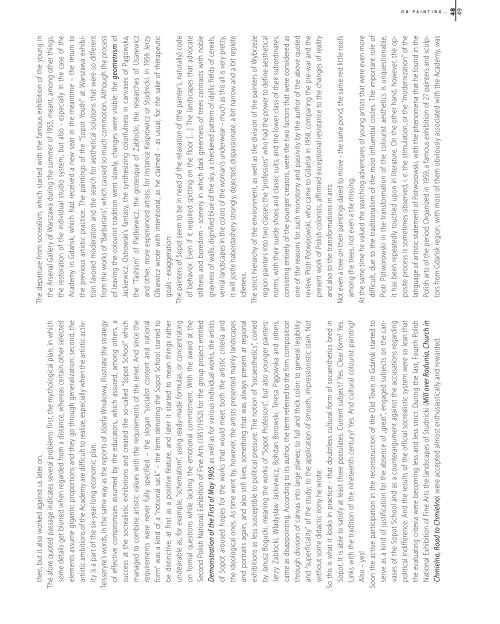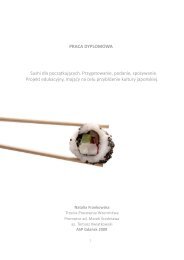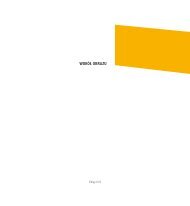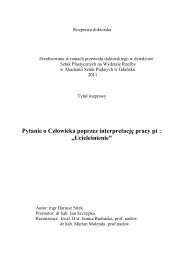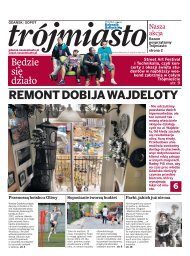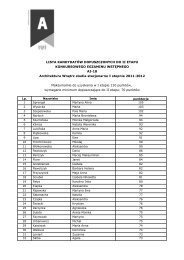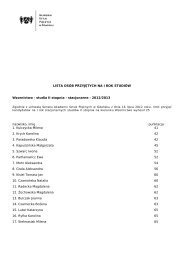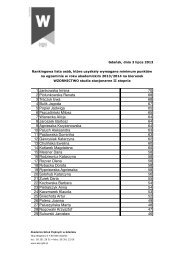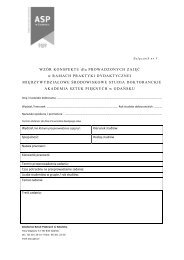P o czet dziek anó w - Akademia Sztuk Pięknych w Gdańsku
P o czet dziek anó w - Akademia Sztuk Pięknych w Gdańsku
P o czet dziek anó w - Akademia Sztuk Pięknych w Gdańsku
Create successful ePaper yourself
Turn your PDF publications into a flip-book with our unique Google optimized e-Paper software.
O N P A I N T I N G … 49<br />
The departure from socrealism, which started with the famous exhibition of the young in<br />
the Arsenal Gallery of Warszawa during the summer of 1955, meant, among other things,<br />
the restoration of the individual studio system, but also - especially in the case of the<br />
Academy in Gdańsk, which had received a new seat in the meantime – the return to<br />
the previous artistic practice. The paintings of the “Sopot Youth” at Warszawa exhibition<br />
favored moderation and the search for aesthetical solutions that were so different<br />
from the works of “Barbarians”, which caused so much commotion. Although the process<br />
of leaving the colourist tradition went slowly, changes were visible: the geometrism of<br />
Jackiewicz, Ostrowski’s fantasy, the synthesizing colorfulness in canvases of Pągowska,<br />
the “Tashism” of Pietkiewicz, the grotesque of Zabłocki, the researches of Usarewicz<br />
and other, more experienced artists, for instance Kasprowicz or Studnicki. In 1956 Jerzy<br />
Olkiewicz wrote with intentional, as he claimed – as usual, for the sake of therapeutic<br />
goals - exaggeration:<br />
The painters of Sopot seem to be in need of the relaxation of (the painter’s, naturally) code<br />
of behavior. Even if it required spitting on the floor […] The landscapes that advocate<br />
stillness and boredom - scenery in which dark greenness of trees contrasts with noble<br />
grayness of walls, dignified blue of the sky, a checkered pattern of idyllic fields of cereals,<br />
vernal landscapes in the colors of the woman’s underwear – much as this all is very pretty,<br />
it will jostle haberdashery strongly, dejected, dispassionate, a bit narrow and a bit replete<br />
idleness.<br />
The strict hierarchy of the environment, as well as the division of the painters of Wybrzeże<br />
region painters into two classes: the “professors” who had the power to define aesthetical<br />
norms, with their suede shoes and classic suits, and the lower class of their subordinates,<br />
consisting entirely of the younger creators, were the two factors that were considered as<br />
one of the reasons for such monotony and passivity by the author of the above quoted<br />
review. Piotr Potworowski, who came to Gdańsk in 1958, comparing the pre-war and the<br />
present work of Polish colorists, affirmed exceptional resistance to the changes of reality<br />
and also to the transformations in arts:<br />
Not even a tree on their paintings dared to move - the same pond, the same red little roofs<br />
among the trees, not even a tile missing.<br />
At the same time he valued the searching adventures of young artists that were even more<br />
difficult, due to the traditionalism of the most influential circles. The important role of<br />
Piotr Potworowski in the transformation of the colourist aesthetics is unquestionable,<br />
it has been repeatedly touched upon in literature. On the other hand, however, the opposite<br />
process is sometimes observed, i. e. the stimulation, or the “modernization” of the<br />
language of artistic statement of Potworowski, with the phenomena that he found in the<br />
Polish arts of the period. Organized in 1959, a famous exhibition of 27 painters and sculptors<br />
from Gdańsk region, with most of them obviously associated with the Academy, was<br />
then, but it also worked against us later on.<br />
The afore quoted passage indicates several problems: first, the mythological plan, in which<br />
some details get blurred when regarded from a distance, whereas certain other selected<br />
elements assume gigantic proportions and they go through generalization; second, the<br />
artistic ambitions of the Academy are difficult to realize, especially when the artistic activity<br />
is a part of the six-year-long economic plan.<br />
Teisseryre’s words, in the same way as the reports of Józefa Wnukowa, illustrate the strategy<br />
of effective compromises assumed by the educators, which assured, among others, a<br />
success at the socrealistic exhibitions and created the so-called “Sopot School” which<br />
managed to combine artistic values with the requirements of the tenet. And since the<br />
requirements were never fully specified – the slogan “socialist content and national<br />
form” was a kind of a “notional sack” – the term denoting the Sopot School started to<br />
be distinctive, at first as a positive feature, and later it started to mean things rather<br />
undesirable as, for example, “schematism”, using ready-made formulas, or concentrating<br />
on formal questions while lacking the emotional commitment. With the award at the<br />
Second Polish National Exhibition of Fine Arts (1951/1952) for the group project entitled<br />
Demonstration of the First of May 1905, as well as for various individual works, the artists<br />
of Sopot aroused hopes for the works that would meet both the artistic criteria and<br />
the ideological ones. As time went by, however, the artists presented mainly landscapes<br />
and portraits again, and also still lives, something that was always present at regional<br />
exhibitions as less susceptible to political pressure. The notion of “socaesthetics”, coined<br />
by Janusz Bogucki, meaning the works of “Sopot Professors”, but also younger painters:<br />
Jerzy Zabłocki, Władysław Jackiewicz, Bohdan Borowski, Teresa Pągowska and others,<br />
came as disappointing. According to its author, the term referred to the firm composition<br />
through division of canvas into large planes; to full and thick color; to general legibility<br />
and “superficiality” of the study; to the application of smooth, impressionistic stain. Not<br />
without some didactic irony he wrote:<br />
So this is what it looks in practice - that doubtless cultural form of socaesthetics bred in<br />
Sopot. It is able to satisfy at least three postulates. Current subject? Yes. Clear form? Yes.<br />
Links with the tradition of the nineteenth century? Yes. And cultural colourist painting?<br />
Also – yes!<br />
Soon the active participation in the reconstruction of the Old Town in Gdańsk started to<br />
serve as a kind of justification for the absence of „great”, engaged subjects on the canvases<br />
of the Sopot School and as a counterargument against the accusations regarding<br />
political indifference. And the results of the official socrealistic system were so lean that<br />
the evaluating criteria were becoming less and less strict. During the last, Fourth Polish<br />
National Exhibition of Fine Arts the landscapes of Studnicki (Mill over Radunia, Church in<br />
Chmielno, Road to Chmielno) were accepted almost enthusiastically and rewarded.<br />
48


